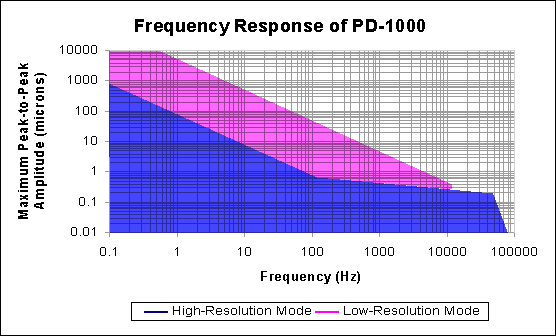Fiber Connectors: FC/APC
Examples of interferometers include a non contact probe for measurement of displacement and vibration, based on a Fizeau cavity, where the reflection from a fiber tip and that from a target interfere to give optical fringes. The advantage of this arrangement is that the target need not be critically aligned. The returned light is dependent on target angle and distance from the optimum focus resulting in a typical range of 2mm for a 10mm working distance and a maximum angular target error of 1 degree. Both software and front-panel LED indicators flag performance limits.
Other applications are dependent on the interferometer configuration. Refractive index changes can be monitored by using transparent cells where the medium contained in the cell changes refractive index. Strain can be measured by all-fiber interferometers, where a length of fiber in a Mach Zehnder or Michelson arrangement is stretched proportional to the strain induced by some mechanical means.
There are two modes of operation: a high-resolution mode, which tracks target motion to within 1 nanometer, and a low-resolution mode which tracks target motion to 0.4 micron accuracy. The limiting target speed in high-resolution mode is 300 microns/sec. When this tracking rate is exceeded, the unit switches to the low-resolution mode, which allows a larger target motion of 20 mm/sec.

Figure 1 above shows the frequency response characteristic for both modes.
In Surface Profiling Applications the low frequency response is more important as it limits the maximum speed of the target. Maximum peak-to-peak amplitude, A, and frequency, F, are related by:
F= max tracking rate / πA,
where A is in mm and F is in Hz.
In low-resolution mode the maximum tracking rate is 20mm/sec:
Thus, Maximum frequency (Hz) = 20/πA,
where A is the maximum peak-to-peak amplitude in mm.
Or, Maximum peak-to-peak amplitude (mm) = 20/πF,
where F is the maximum frequency in Hz.
In high-resolution mode the maximum tracking rate is 300 microns/sec:
Thus, Maximum frequency (Hz) = 0.3/πA,
where A is the maximum peak-to-peak amplitude in mm.
Or, Maximum amplitude (mm) = 0.3/πF,
where F is in Hz.
Where vibration or smaller amplitude surface texture is present the higher frequency response is important. Above 100 Hz the amplitude begins to roll off from nominally 1 microns peak-to-peak to 0.2 microns at 50 KHz
For higher frequency applications such as acoustic signals an interferometer that has a maximum path length change of +/- 0.2 microns peak-to-peak allows a flat response to 50 kHz. Acoustic sensors made from cylinders and diaphragms are an example.